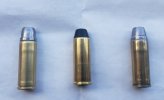BigBearJoe
Member
RCBS 45 255 KT (left), Ficcochi 45 LCCA factory (middle), Lyman 452424 (right)
 5 Colt Bullet Shootout
5 Colt Bullet Shootout
RCBS 45-255 KT cast lead bullet (257g lubed and sized) vs. Lyman 452424 cast bullet (253g lubed and sized) vs new Fiocchi 45 LCCA factory "cowboy action" coated ammo (250g lead coated per product label).
Well, I made it to the Big Bear Valley Sportsman's shooting range again today. It was beautiful weather. The project was to compare two different Elmer Keith style cast lead bullets, both loaded identically with 7.0 g Win 231 and CCI 300 large pistol primers. I had a box of new 250 g Fiocchi 250 g lead round nose flat point that came with a recent 1858 Remington New Army 44 percussion conversion gun purchase.
But anyhow, three groups of six shots each were fired from a S&W Model 25-7 from a Caldwell bag rest at 17 yards. Photos of thr targets are attached.
I have to give a slight edge in accuracy to the RCBS 45 255 KT bullet over the Lyman 452424. Both of the cast lead bullets did far better than the factory coated bullet.
RCBS - 2.0" group
Lyman 452424 - 3.1" group
Fiocchi 45 LCCA factory coated 250g cowboy loads - 4.3" group
*All groups fired from a Caldwell bag rest at 17 yds. Test gun S&W Model 25-7, 5" barrel
There are two main factors (at least) that I believe impact the differences in accuracy between these three bullet types, namely the bullet diameter and the overall cartridge length.
First, the RCBS is a 0.454" díameter bullet, whereas the other two are 0.452". My test gun seems to do better with the slightly larger diameter bullet. Second, Elmer Keith believed that a proper cast bullet for wheel guns should have more of the bullet weight protruding out of the brass case beyond the crimp groove than that weight which is inside the case. In this test all of the bullet weights were within 7 grains if one another, therefore the cartridge overall length (COAL) gives an indication for the relative amount of lead sticking out beyond the brass. The COALs are as follows:
RCBS - 1.662"
Lynan - 1.636"
Fiocchi - 1.548"
Therefore, the RCBS has more weight sticking out in front of the case crimp and has the shortest "jump" from cylinder to forcing cone of these three rounds.
The clear winner of today's range fun was RCBS! But the experiments will continue. I have good supplies of Unique, Tight Group, and 4227 on hand and will continue side-by-side comparisons of the RCBS and Lyman bullets using these powders
 5 Colt Bullet Shootout
5 Colt Bullet ShootoutRCBS 45-255 KT cast lead bullet (257g lubed and sized) vs. Lyman 452424 cast bullet (253g lubed and sized) vs new Fiocchi 45 LCCA factory "cowboy action" coated ammo (250g lead coated per product label).
Well, I made it to the Big Bear Valley Sportsman's shooting range again today. It was beautiful weather. The project was to compare two different Elmer Keith style cast lead bullets, both loaded identically with 7.0 g Win 231 and CCI 300 large pistol primers. I had a box of new 250 g Fiocchi 250 g lead round nose flat point that came with a recent 1858 Remington New Army 44 percussion conversion gun purchase.
But anyhow, three groups of six shots each were fired from a S&W Model 25-7 from a Caldwell bag rest at 17 yards. Photos of thr targets are attached.
I have to give a slight edge in accuracy to the RCBS 45 255 KT bullet over the Lyman 452424. Both of the cast lead bullets did far better than the factory coated bullet.
RCBS - 2.0" group
Lyman 452424 - 3.1" group
Fiocchi 45 LCCA factory coated 250g cowboy loads - 4.3" group
*All groups fired from a Caldwell bag rest at 17 yds. Test gun S&W Model 25-7, 5" barrel
There are two main factors (at least) that I believe impact the differences in accuracy between these three bullet types, namely the bullet diameter and the overall cartridge length.
First, the RCBS is a 0.454" díameter bullet, whereas the other two are 0.452". My test gun seems to do better with the slightly larger diameter bullet. Second, Elmer Keith believed that a proper cast bullet for wheel guns should have more of the bullet weight protruding out of the brass case beyond the crimp groove than that weight which is inside the case. In this test all of the bullet weights were within 7 grains if one another, therefore the cartridge overall length (COAL) gives an indication for the relative amount of lead sticking out beyond the brass. The COALs are as follows:
RCBS - 1.662"
Lynan - 1.636"
Fiocchi - 1.548"
Therefore, the RCBS has more weight sticking out in front of the case crimp and has the shortest "jump" from cylinder to forcing cone of these three rounds.
The clear winner of today's range fun was RCBS! But the experiments will continue. I have good supplies of Unique, Tight Group, and 4227 on hand and will continue side-by-side comparisons of the RCBS and Lyman bullets using these powders



